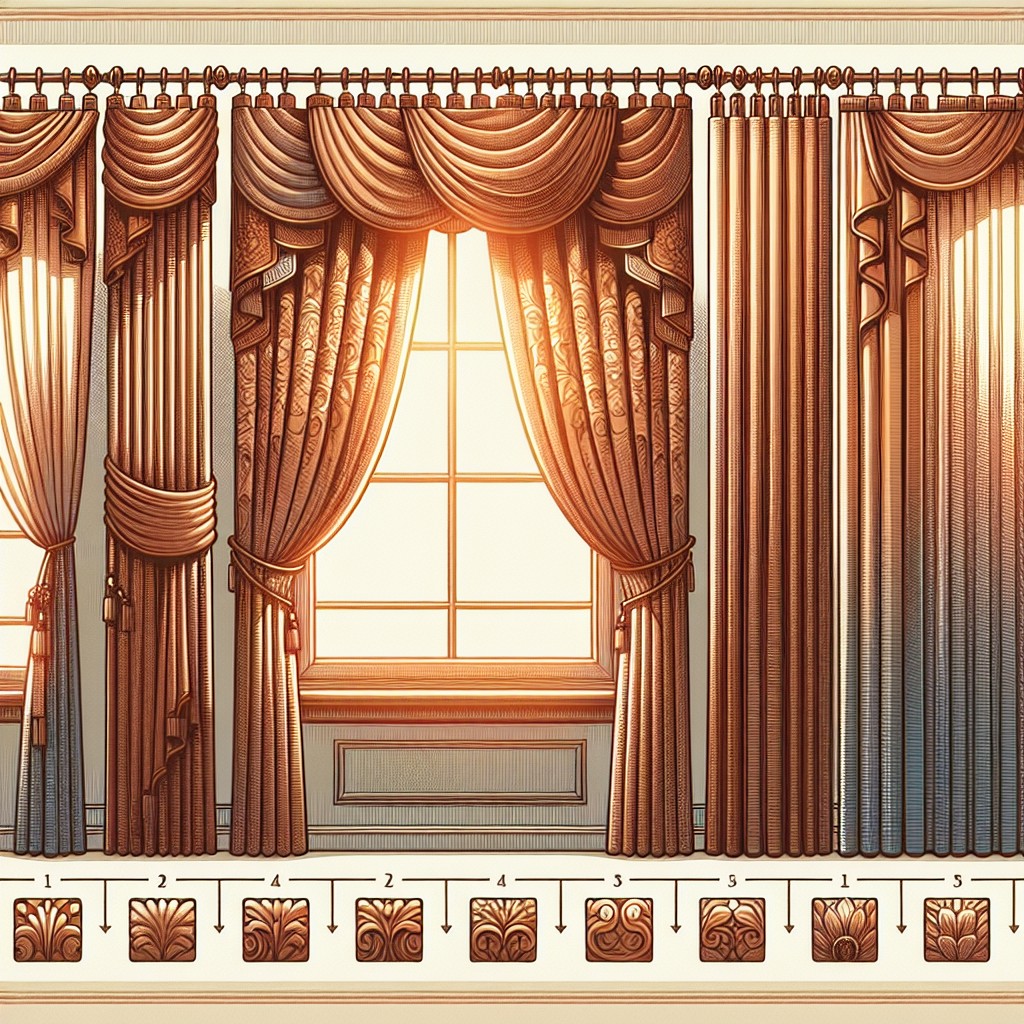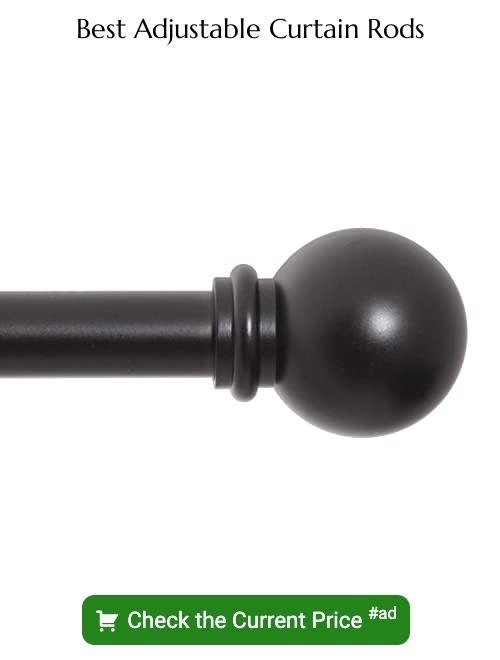Choosing the right curtain panel width can transform your home’s aesthetic because it’s not just about fabric choice – the fit and flow can make all the difference.
Key takeaways:
- Curtain panel width is crucial for both functionality and aesthetics.
- Standard panel widths range from 54 to 108 inches.
- Consider window size, desired fullness, opening and closing, pattern alignment, and light control when determining the ideal width.
- Fullness ratio is typically 2:1, but it can vary depending on fabric, style, and functionality.
- Stack back width should be calculated to ensure curtains don’t obstruct windows when opened.
The Importance of Proper Curtain Panel Width

Selecting the right curtain panel width isn’t merely a matter of taste—it’s crucial for both functionality and aesthetics. The appropriate width ensures adequate privacy and light control. Too narrow, and gaps may let in unwanted light or compromise privacy. Excessively wide panels, on the other hand, can appear bulky and overwhelm the space.
Curtains that fit properly have a polished look and contribute to the room’s overall ambiance. Moreover, they enhance insulation by creating an additional barrier to heat loss or gain through the window, contributing to energy efficiency. Properly sized curtain panels allow for the ideal amount of fullness when drawn closed, which is typically 2 to 2.5 times the width of the window for standard curtain materials.
Remember, the goal is to strike a balance between form and function—the right width not only complements your window proportions but also performs effectively.
Standard Curtain Panel Widths

Standard panel widths typically range from 54 inches to 108 inches. Most ready-made curtains come in these dimensions:
– **54 inches:** This width is commonly found and designed to fit average-sized windows when combined with multiple panels. – **72 inches:** A slightly wider option, giving a fuller look when used in pairs, suitable for moderate to large windows. – **96 inches:** Ideal for larger windows or sliding doors, providing substantial coverage with fewer panels. – **108 inches:** Often employed for expansive window areas or when desiring extensive fabric folds for a luxurious feel.Multiple panels can be combined for greater fullness or to accommodate wider windows. Manufacturers produce these standard widths to match the typical window sizes found in homes. Always double-check your window measurements against the panel specifications to ensure proper coverage.
Determining the Ideal Curtain Panel Width
When assessing the ideal width for your curtain panels, consider both the functional and decorative aspects of your window treatments:
1. Window Size: Measure the width of your window frame. This measurement serves as the baseline for determining the required curtain width.
2. Desired Fullness: Achieve a fuller look by choosing curtain panels that are two to three times the width of your window. More fullness equals more fabric and a richer appearance.
3. Opening and Closing: If the curtains need to be operational, ensure the panels can move effortlessly across the rod, which typically means accounting for additional fabric.
4. Pattern Alignment: For curtains with patterns or prints, factor in the necessity of pattern matching at the seams, which may demand wider panels.
5. Light Control: Wider panels can overlap in the center when closed, offering better light blocking and privacy.
6. Layering: Plan for the presence of sheer or secondary curtains underneath, which might influence the width of the outer decorative panels.
Remember to take into account any additional space the curtains will occupy when drawn back beside the window, referred to as the stack back, which can affect the overall width needed.
The Fullness Factor
Understanding the concept of fullness is critical in achieving the desired look and function for your curtains. Fullness refers to the ratio of the actual fabric width to the width of the window it is covering.
Here are some key points to consider:
- Standard Fullness: Typically, curtains have a fullness ratio of 2:1, meaning the fabric width is twice that of the window width, which creates a pleasing gather.
- Sheer Fabrics: For sheer curtains, a fullness of 2.5:1 or even 3:1 may be desirable to provide an adequate coverage while maintaining a delicate appearance.
- Room Aesthetics: For a more luxurious or traditional look, consider increasing the fullness ratio. For a contemporary or minimalist decor, you might opt for a lower fullness.
- Fabric Weight: Heavier fabrics might not require as much fullness because they have less natural drape; lighter fabrics may require more to achieve the same level of fullness.
- Functionality: Remember that increasing fullness may also impact the curtain’s functionality—more fabric requires more stack back space when curtains are open.
- Cost Consideration: More fabric means increased costs, so balance the aesthetic benefits of fullness with your budget.
By adjusting the fullness factor, you can tailor the look of your curtain panels to fit both the style and practical needs of your space.
Calculating Stack Back Width
Stack back refers to the amount of space needed when the curtains are fully opened. To ensure your window is not obscured by curtains when they’re drawn back, take into account the following:
- Measure the width of the curtain rod excluding any finials.
- Divide this number by 3; this calculation typically provides an ideal stack back width per panel.
- Factor in additional space if your curtains are made of a thicker fabric, such as velvet, to accommodate the bulk.
- Remember to include room for overlap where your curtains meet in the middle if you’re using two panels.
- For a seamless look when the curtains are drawn, consider the depth of the window sill and any obstacles such as handles that may impact how the curtain sits.
- Using tiebacks can also affect stack back, pulling the fabric tighter against the wall and reducing the width needed.
- Lastly, ensure the stack back doesn’t impede the function of doors or windows within the curtain area.
Panel Width Vs. Window Width Relation
To ensure aesthetic appeal and functionality, curtain panels should be wider than the window they cover. A common guideline suggests that panels should be 1.5 to 3 times the width of the window for adequate fullness when closed.
Here are a few points to remember:
- For a gathered look, opt for curtains that are at least 2 times the width of the window.
- Just covering the window frame requires panels that are 1.5 times the window width.
- A fuller, more luxurious appearance might need curtains up to 3 times the width.
- Always account for the space curtains will take up when drawn open, known as “stack back,” to prevent blocking too much of the window.
- Factor in additional width for overlapping in the center if using two panels for one window.
Custom Vs. Off-the-Shelf Panel Widths
Choosing between custom and off-the-shelf curtain panels largely depends on your specific window measurements and design preferences.
Custom Panels:
- Tailored to fit: They offer a perfect fit for windows with non-standard sizes.
- Design freedom: An array of styles, fabrics, and patterns are at your disposal.
- Longer lead time: They require a waiting period for fabrication.
- Higher cost: Customization comes at a premium compared to ready-made options.
Off-the-Shelf Panels:
- Convenience: These are readily available at most home decor stores.
- Affordability: Generally less expensive due to mass production.
- Limited sizing: Typically offered in a few standard widths, requiring more panels for proper coverage.
- Immediate installation: No wait times—they can be installed as soon as they are purchased.
Whether opting for the personalized touch of custom curtains or the convenience of ready-made panels, consider the balance between aesthetics, function, and budget to make the suitable choice for your space.
Measuring Tips for Curtain Panel Width
To ensure accuracy when measuring for curtain widths, follow these guidelines:
1. Use a metal measuring tape for precise readings.
2. Measure the window frame width from outside edge to outside edge. For drywall or trim, measure from edge to edge.
3. Consider the desired fullness of the curtains – more fabric equals more fullness.
4. Add extra width to your measurement to account for the curtain rod extending beyond the window frame, usually 3 to 6 inches on each side.
5. If covering a wide window or wanting a draped look, double or even triple the window width.
6. For grommet or ring-top curtains, factor in the space between the edge of the panel and the first grommet when fully stretched.
7. For existing curtain rods, measure the rod length, not the window itself.
8. Record measurements to the nearest 1/8-inch for precision.
9. Repeat the measuring process to confirm the dimensions.
By keeping these points in mind, the width of curtain panels can be determined with certainty, ensuring an aesthetically pleasing and functional window treatment.
Adjusting Panel Width for Aesthetics and Function
When optimizing the width of your curtain panels for aesthetics and function, consider the following:
1. Layering: Incorporate sheer panels behind your main curtains for a sophisticated look. This not only adds depth to your window treatments but also allows you to adjust light and privacy levels easily.
2. Symmetry: For visual harmony, ensure that panels on either side of the window are of equal width. This balance is pleasing to the eye and creates a sense of order in the space.
3. Overlapping: Allow your curtain panels to overlap slightly in the middle when closed. This prevents light gaps and offers a seamless look.
4. Floor Clearance: If your curtains will be opened and closed frequently, opt for a width that ensures minimal dragging on the floor. This helps avoid wear and tear and maintains the curtain’s clean lines.
5. Functionality: For sliding doors or frequent access to windows, wider panels can be practical, providing the necessary clearance for ease of use without compromising on style.
Special Considerations for Pleated Curtain Panels
Pleated curtain panels add elegance and structure to a room, but they require precise measurements to ensure a tailored look. Consider the type of pleat as it influences the amount of fabric used and, consequently, the panel width. Pinch pleats, for instance, will use more fabric than box pleats.
When selecting pleated panels, account for the fact that they are usually hung on rings, which can raise the panel slightly above the rod – affecting length rather than width. To achieve the desired fullness, order pleated curtains at least twice the width of the track or pole they will hang from.
Keep in mind that pleated curtains are typically fixed in width and cannot be adjusted once made. Accurate measurements are crucial. It’s advisable to consult with a professional or refer to the manufacturer’s guidelines to determine the exact amount of fabric needed for your specific window size.
When it comes to pleated panels, consider interlining – a fabric layer between the lining and the main fabric – which can add body, improve insulation, and contribute to the drapes’ overall fullness, affecting the panel dimensions.
Remember to allow for overlap where the panels meet in the center of the window and consider the ‘return’ to the wall on both ends of the curtain, which is the space the curtain covers from the last hook or ring to the wall, to ensure full coverage and a polished appearance.
Dealing With Extra Wide Windows
Extra wide windows present a unique challenge when selecting the appropriate curtain panels. To cover them effectively:
- Opt for multiple standard-width panels rather than a single wide one to allow for better movement and flexibility.
- Consider the addition of extra panels to achieve the desired fullness, giving a luxurious, gathered look to the curtains when closed.
- Ensure the added panels match in terms of fabric, pattern, and color for a cohesive appearance.
- Divide the width of the window by the width of your chosen curtain panels to determine how many are needed for full coverage.
- Remember to account for the fullness factor; more fabric creates a richer look.
- Choose a strong curtain rod that can support the weight of multiple panels without sagging.
Ensuring Consistency Across Multiple Windows
To maintain a uniform look throughout your space when dressing multiple windows:
1. Use the same fabric and style for all window treatments. Differences in material or pattern can disrupt the visual flow.
2. Measure each window carefully, even if they look identical. Slight size variances can exist and impact the overall symmetry.
3. Consider the room’s layout. Windows on the same wall should have identical curtain widths, but this rule can be flexible if windows are on different walls and not visible to each other at the same time.
4. Align the curtain tops at the same height, even if the window frames are at different levels. This creates a cohesive look.
5. Ensure the curtain rods or tracks are the same style and color, as this hardware can significantly impact the visual consistency.
6. If dealing with bay or bow windows, treat them as one continuous window for the purpose of consistency, using a single curtain track or rod where possible.
Selecting Curtain Rods for Your Panel Width
Selecting the correct curtain rod is vital to complement your curtain panel width and ensure the drapery functions smoothly. Go for a rod that extends beyond the width of your panel by at least 6 inches on each side. This allows the curtains to be pulled back fully, ensuring maximum natural light and minimal blockage when open.
The diameter of the rod should align with the weight and style of your curtains: heavier curtains require sturdier rods, while lighter panels work well with slimmer rods. Remember that the rod style should match your room’s decor: ornate finials for a classic look or minimalistic ends for a modern touch.
Lastly, when opting for adjustable-length curtain rods, ensure they can extend to a size appropriate for both your window and the panel width to provide ample support and proper visual balance.
Maintaining and Cleaning Your Curtain Panels
To keep your curtain panels looking fresh, regular maintenance is key. Dust and dirt can accumulate, dulling the fabric’s appearance.
Lightly vacuuming with a brush attachment every month can prevent this buildup. For deeper cleaning, consult the care label. Many curtains are machine washable, but use a gentle cycle with cool water and mild detergent. For those that are dry clean only, periodic professional cleaning will preserve the fabric integrity.
If wrinkles persist after washing or dry cleaning, most curtains can be ironed on a low setting, though sheer or delicate materials may require a steamer. To avoid mildew, never put damp curtains back up; ensure they are fully dry.
Finally, to protect the fabric from sun damage and fading, consider using a liner or choosing a window treatment location that doesn’t receive direct sunlight all day. Regular care will not only prolong the life of your curtains but also keep your windows looking their best.
FAQ
What widths do curtain panels come in?
Curtain panels come in three standard widths: 112 cm (44 inches), 167 cm (66 inches), and 228 cm (90 inches).
How wide should side curtain panels be?
The recommended width for side curtain panels should be two to two and a half times as wide as their dressed or stacked back width.
How wide should a curtain panel be for a 30 inch window?
For a 30-inch window, the curtain panel should have a combined width of 60 to 75 inches considering both Grommet style or Rod-pocket style.
How wide should curtains be for a 72 inch window?
For a 72 inch window, the ideal curtain width should be between 108 inches (1.5 times the window width) and 216 inches (three times for sheers), and for a full look, use two panels of 72 inches each.
How does the type of window affect the required curtain panel width?
The type of window dictates the required curtain panel width as larger or uniquely shaped windows necessitate wider or multiple curtain panels for adequate coverage and aesthetic balance.
What are the best curtain panel widths for bay windows?
The best curtain panel widths for bay windows typically range between 20 to 36 inches, depending on the precise measurement of each window section.
Do double-hung windows require wider curtain panels?
Double-hung windows do not inherently require wider curtain panels; curtain width depends on window size, desired level of privacy, and aesthetic preference.
Related Stories
- How Far Past Window Should Curtain Rod Go: A Comprehensive Guide to Curtain Rod Placement and Installation
- How Much Fabric for Curtains: Comprehensive Guide and Tips
- How to Calculate Curtain Width: Accurate Guide for Perfect Measurements
- How to Measure for Valances: Step-by-Step Guide for Perfect Window Treatments
- How to Use Drapery Pins: A Comprehensive Step-by-Step Guide
Recap

